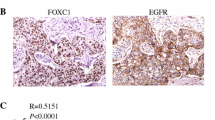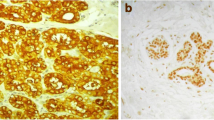Abstract
Expression of the JAG1 Notch ligand has previously been shown to correlate with poor overall survival in women with advanced breast cancer. We undertook to test whether expression of JAG1 is associated with reduced disease free survival (DFS) in 887 samples from a prospectively accrued LNN cohort with a median follow-up greater than 8 years. Moderate to high JAG1 mRNA expression was associated with reduced DFS in univariate analysis (hazard ratio of 1.58; 95% confidence interval, 1.03–2.40; P = 0.034) and correlated with large tumor size, ER and PgR negativity, high tumor grade, and p53 antibody reactivity. Although elevated risk of reduced DFS in patients with high JAG1 mRNA did not persist with adjustment for other prognostic factors, it did in combination with HER2. JAG1 mRNA was positively associated with expression of basal breast cancer markers, however, in contrast to the finding that basal gene expression is most strongly associated with reduced DFS in the first 36 months of follow-up, JAG1 mRNA expression was associated with reduced DFS through the full follow-up period. Also, tumors expressing high levels of both mRNA and protein showed reduced DFS as compared to all other groups in univariate analysis (hazard ratio of 1.73; 95% confidence interval, 1.09–2.74; P = 0.020). Thus, JAG1 expression is associated with poor DFS in LNN breast cancer. As JAG1 is a target of several oncogenic signaling pathways, and is a ligand for Notch, these data provide novel insights into signaling that may contribute to progression of early stage breast cancer.


Similar content being viewed by others
References
Fan C, Oh DS, Wessels L et al (2006) Concordance among gene-expression-based predictors for breast cancer. N Engl J Med 355(6):560–569
Sorlie T, Perou CM, Tibshirani R et al (2001) Gene expression patterns of breast carcinomas distinguish tumor subclasses with clinical implications. Proc Natl Acad Sci USA 98(19):10869–10874
Sorlie T, Tibshirani R, Parker J et al (2003) Repeated observation of breast tumor subtypes in independent gene expression data sets. Proc Natl Acad Sci USA 100(14):8418–8423
Bull SB, Ozcelik H, Pinnaduwage D et al (2004) The combination of p53 mutation and neu/erbB-2 amplification is associated with poor survival in node-negative breast cancer. J Clin Oncol 22(1):86–96
Rakha EA, El-Rehim DA, Paish C et al (2006) Basal phenotype identifies a poor prognostic subgroup of breast cancer of clinical importance. Eur J Cancer 42(18):3149–3156
Rakha EA, El-Sayed ME, Green AR et al (2007) Prognostic markers in triple-negative breast cancer. Cancer 109(1):25–32
Callahan R, Raafat A (2001) Notch signaling in mammary gland tumorigenesis. J Mammary Gland Biol Neoplasia 6(1):23–36
Callahan R, Egan SE (2004) Notch signaling in mammary development and oncogenesis. J Mammary Gland Biol Neoplasia 9(2):145–163
Robbins J, Blondel BJ, Gallahan D et al (1992) Mouse mammary tumor gene int-3: a member of the notch gene family transforms mammary epithelial cells. J Virol 66(4):2594–2599
Dievart A, Beaulieu N, Jolicoeur P (1999) Involvement of Notch1 in the development of mouse mammary tumors. Oncogene 18(44):5973–5981
Parr C, Watkins G, Jiang WG (2004) The possible correlation of Notch-1 and Notch-2 with clinical outcome and tumour clinicopathological parameters in human breast cancer. Int J Mol Med 14(5):779–786
Pece S, Serresi M, Santolini E et al (2004) Loss of negative regulation by Numb over Notch is relevant to human breast carcinogenesis. J Cell Biol 167(2):215–221
Stylianou S, Clarke RB, Brennan K (2006) Aberrant activation of notch signaling in human breast cancer. Cancer Res 66(3):1517–1525
Reedijk M, Odorcic S, Chang L et al (2005) High-level coexpression of JAG1 and NOTCH1 is observed in human breast cancer and is associated with poor overall survival. Cancer Res 65(18):8530–8537
Dickson BC, Mulligan AM, Zhang H et al (2007) High-level JAG1 mRNA and protein predict poor outcome in breast cancer. Mod Pathol 20(6):685–693
Andrulis IL, Bull SB, Blackstein ME et al (1998) neu/erbB-2 amplification identifies a poor-prognosis group of women with node-negative breast cancer. Toronto Breast Cancer Study Group. J Clin Oncol 16(4):1340–1349
Fleiss JL (1981) Statistical methods for rates and proportions, 2nd edn. John Wiley & Sons, Inc., New York
Therneau T, Grambsch P (2000) Modelling survival data: extending the cox model
Holland EC, Hively WP, DePinho RA et al (1998) A constitutively active epidermal growth factor receptor cooperates with disruption of G1 cell-cycle arrest pathways to induce glioma-like lesions in mice. Genes Dev 12(23):3675–3685
Wang JC, Dick JE (2005) Cancer stem cells: lessons from leukemia. Trends Cell Biol 15(9):494–501
Callahan R, Smith GH (2000) MMTV-induced mammary tumorigenesis: gene discovery, progression to malignancy and cellular pathways. Oncogene 19(8):992–1001
Roy M, Pear WS, Aster JC (2007) The multifaceted role of Notch in cancer. Curr Opin Genet Dev 17(1):52–59
Miele L, Golde T, Osborne B (2006) Notch signaling in cancer. Curr Mol Med 6(8):905–918
Dontu G, Jackson KW, McNicholas E et al (2004) Role of Notch signaling in cell-fate determination of human mammary stem/progenitor cells. Breast Cancer Res 6(6):R605–R615
Sansone P, Storci G, Giovannini C et al (2007) p66Shc/Notch-3 interplay controls self-renewal and hypoxia survival in human stem/progenitor cells of the mammary gland expanded in vitro as mammospheres. Stem Cells 25(3):807–815
Farnie G, Clarke RB, Spence K et al (2007) Novel cell culture technique for primary ductal carcinoma in situ: role of Notch and epidermal growth factor receptor signaling pathways. J Natl Cancer Inst 99(8):616–627
Thurston G, Noguera-Troise I, Yancopoulos GD (2007) The Delta paradox: DLL4 blockade leads to more tumour vessels but less tumour growth. Nat Rev Cancer 7(5):327–331
Zeng Q, Li S, Chepeha DB et al (2005) Crosstalk between tumor and endothelial cells promotes tumor angiogenesis by MAPK activation of Notch signaling. Cancer Cell 8(1):13–23
Ikeuchi T, Sisodia SS (2003) The Notch ligands, Delta1 and Jagged2, are substrates for presenilin-dependent “gamma-secretase” cleavage. J Biol Chem 278(10):7751–7754
Bash J, Zong WX, Banga S et al (1999) Rel/NF-kappaB can trigger the Notch signaling pathway by inducing the expression of Jagged1, a ligand for Notch receptors. Embo J 18(10):2803–2811
Katoh M, Katoh M (2006) Notch ligand, JAG1, is evolutionarily conserved target of canonical WNT signaling pathway in progenitor cells. Int J Mol Med 17(4):681–685
Ambler CA, Watt FM (2007) Expression of Notch pathway genes in mammalian epidermis and modulation by beta-Catenin. Dev Dyn
Estrach S, Ambler CA, Lo Celso C et al (2006) Jagged 1 is a beta-catenin target gene required for ectopic hair follicle formation in adult epidermis. Development 133(22):4427–4438
Sasaki Y, Ishida S, Morimoto I et al (2002) The p53 family member genes are involved in the Notch signal pathway. J Biol Chem 277(1):719–724
Laurikkala J, Mikkola ML, James M et al (2006) p63 regulates multiple signalling pathways required for ectodermal organogenesis and differentiation. Development 133(8):1553–1563
McGlinn E, van Bueren KL, Fiorenza S et al (2005) Pax9 and Jagged1 act downstream of Gli3 in vertebrate limb development. Mech Dev 122(11):1218–1233
Hallikas O, Palin K, Sinjushina N et al (2006) Genome-wide prediction of mammalian enhancers based on analysis of transcription-factor binding affinity. Cell 124(1):47–59
Acknowledgments
The authors would like to thank Keli Xu, Brenda Cohen and other members of the Egan and Andrulis laboratories for valuable advice and support. The authors also gratefully acknowledge the technical expertise of Suzanna Tjan and the contributions of the Toronto Breast Cancer Group to this work. This work was supported by the National Cancer Institute of Canada with funds from the Terry Fox Run (S.B.B, F.P.O’M., S.E.E, I.L.A) as well as by the Canadian Breast Cancer Foundation (S.E.E. and M.R.). M.R. is supported by the Society of University Surgeons. S.B.B. is supported by a Senior Investigator award from the Canadian Institutes of Health Research and by project funds from the NCE in Mathematics (MITACS). Finally, we thank the patients for their generous donation of tumor samples used in this study.
Author information
Authors and Affiliations
Corresponding authors
Additional information
M. Reedijk and D. Pinnaduwage contributed equally to this work.
Electronic supplementary material
Below is the link to the electronic supplementary material.
Rights and permissions
About this article
Cite this article
Reedijk, M., Pinnaduwage, D., Dickson, B.C. et al. JAG1 expression is associated with a basal phenotype and recurrence in lymph node-negative breast cancer. Breast Cancer Res Treat 111, 439–448 (2008). https://doi.org/10.1007/s10549-007-9805-3
Received:
Accepted:
Published:
Issue Date:
DOI: https://doi.org/10.1007/s10549-007-9805-3




